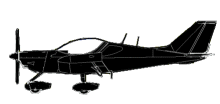
ASN Wikibase Occurrence # 281848
This information is added by users of ASN. Neither ASN nor the Flight Safety Foundation are responsible for the completeness or correctness of this information.
If you feel this information is incomplete or incorrect, you can submit corrected information.
| Date: | Wednesday 22 April 2020 |
| Time: | 11:10 LT |
| Type: |  CSA PiperSport |
| Owner/operator: | Platinum Aviation |
| Registration: | N802PS |
| MSN: | P1001032 |
| Year of manufacture: | 2010 |
| Total airframe hrs: | 1404 hours |
| Engine model: | Rotax 912ULS |
| Fatalities: | Fatalities: 0 / Occupants: 1 |
| Aircraft damage: | Substantial |
| Category: | Accident |
| Location: | Logan-Cache Airport, UT (LGU/KLGU) -
 United States of America United States of America
|
| Phase: | Take off |
| Nature: | Training |
| Departure airport: | Logan-Cache Airport, UT (LGU/KLGU) |
| Salt Lake City, UT (U42) | |
| Investigating agency: | NTSB |
| Confidence Rating: |
The student pilot was making his second solo cross-country flight. He completed the first leg and shut down the engine. When he restarted the engine to begin the next leg of the flight, it momentarily lost power during the magneto check, and he shut it down. After consulting his flight instructor by cell phone, he again started the engine, but the electric fuel pump sounded much louder than usual, so he shut the engine down. On the third engine start, the electric fuel pump remained louder than normal, and he noticed that the fuel pressure was fluctuating. The fuel pressure recovered to 3.5 pounds per square inch (psi), and he completed a normal engine run-up.
Shortly thereafter, the pilot departed. As the airplane reached about 50 to 100 ft above ground level, the engine surged, and he noticed that the fuel pressure had decreased to 1.0 psi. He retarded the throttle to land. The airplane touched down hard and sustained substantial damage to the fuselage.
After the accident, the engine was started and run for several minutes multiple times with no anomalies noted. Testing of the electric fuel pump revealed that it made a loud noise when air passed through it; therefore, the noise heard by the pilot during the engine starts was likely due to air in the fuel system. The accident airplane did not have a fuel bypass around the electric fuel pump, which the engine manufacture's installation instructions warn is a necessary safeguard.
Examination of onboard engine monitoring data revealed that during the climb, the fuel pressure suddenly decreased to 1.1 psi, and the fuel flow simultaneously reached 9.8 gallons per hour. The fuel flow continued to oscillate indicating that the fuel flow to the engine was experiencing intermittent interruptions consistent with fuel vaporizing in the fuel lines (vapor lock).
Probable Cause: A partial loss of engine power during takeoff due to vapor lock.
Accident investigation:
 |
|
Sources:
NTSB WPR20LA145
Location
Revision history:
| Date/time | Contributor | Updates |
|---|---|---|
| 21-Aug-2022 18:59 | ASN Update Bot | Added |
Corrections or additions? ... Edit this accident description
The Aviation Safety Network is an exclusive service provided by:


 ©2024 Flight Safety Foundation
©2024 Flight Safety Foundation